Abstract
The paper describes the characteristics and potential of d_archive’s method in 3D modeling of high quality replicas of fashion artefacts. d_archive is an emerging project with the purpose to support the preservation of fashion heritage and make it accessible digitally, since 2022 the collective is collaborating with various institutions to develop a specific approach to the digitalisation of fashion objects – garments and accessories. Their method is defined by the collective as “digital craftsmanship,” because it involves several skills and knowledge that allow the translation from the physical to the digital. The method is explored in the article via three case studies, as representative models, developed in collaboration with the ModeMuseum Antwerpen. The case studies are contextualised by a theoretical framework in the field of material culture analysis for fashion research; digitalisation and interoperability; workshop and participatory pedagogies for fashion. By reading and analysing the case study, three main characteristics of d_archive methodology emerge: the involvement of analogue techniques such as pattern drafting and sewing, but also fashion design knowledges and skills fostered by participatory activity with the use of a study collection; the characteristics of “digital craftsmanship” a skillful method wherein digital objects are gradually crafted in all the details; the role of artefacts digitisation for fashion research, considering the potential of d_archive’s method that does not aim to overcome object based and material research, but rather to integrate it, opening up multiple possibilities for further interpretation of fashion sources–thanks to interoperability of the digital files.
Introduction
The work of d_archive – an emerging project with the purpose to support the preservation of fashion heritage and make it accessible digitally1 – showcases the potential of researching fashion through objects, while experimenting and evolving methods for material culture analysis and object based research for the study of garments and accessories conserved within GLAMs (Galleries, libraries, archives, museums). Their practice serves to define a method for the study of fashion material cultural heritage – garments and accessories – that merges practices and knowledge from fashion design – including pattern-making and textile research – with museum studies, conservation, history, but also 3D modeling and digitalisation competencies. The positioning map (Figure 1) highlights key areas related to d_archive and it places the project at the intersection of several domains:
FIGURE 1
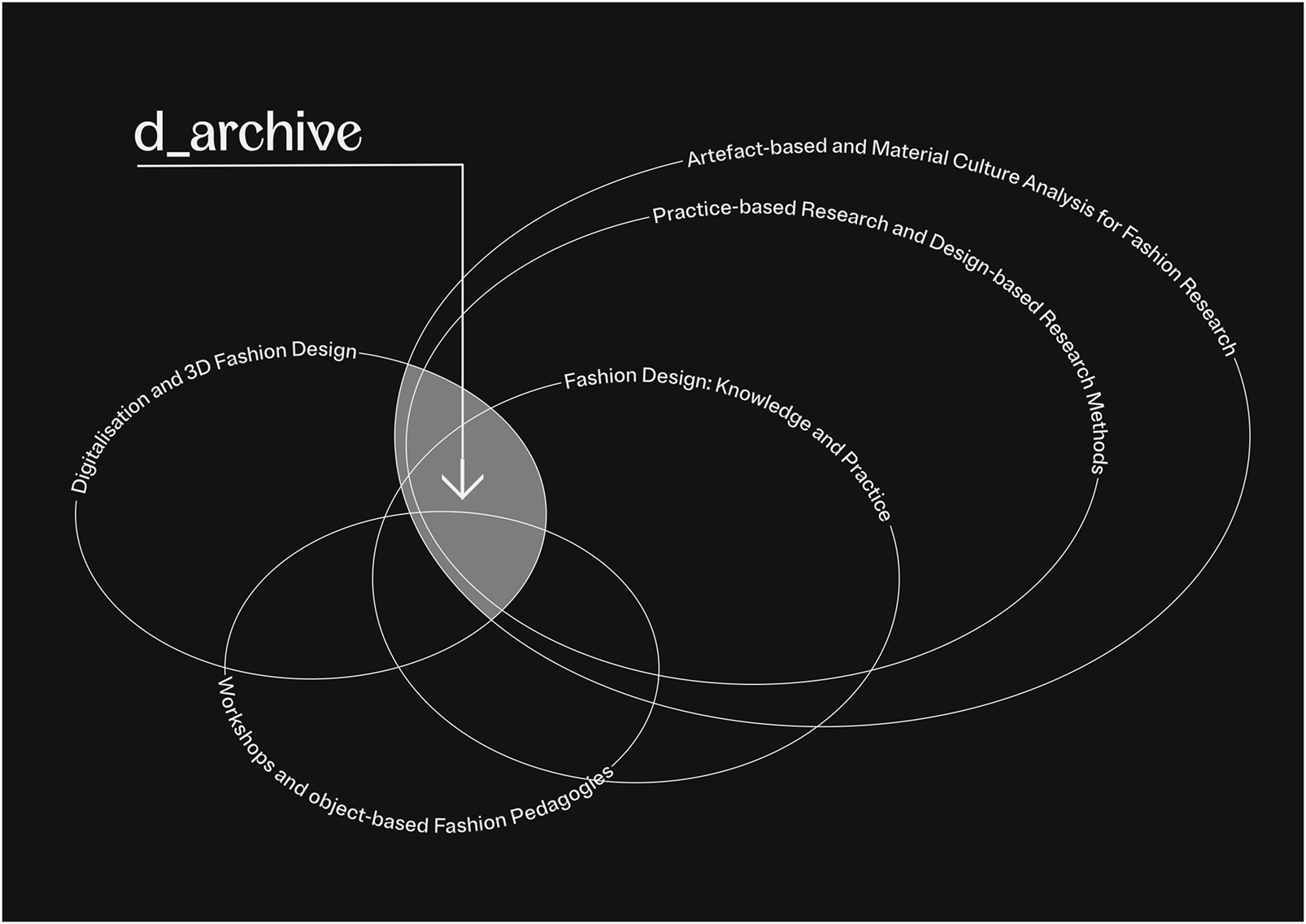
Positioning map of d_archive.
The paper reads d_archive’s method and practice as positioned in a macro-area that concerns methods and methodologies: (1) artefact-based and material culture analysis for fashion research, wherein (2) practice-based and design-based research methods are positioned. Within this context, the method of d_archive can be seen as the intersection between the aforementioned area – strongly connected to fashion heritage – and the field of (3) digitalisation and 3D fashion design, that emphasises the integration of digital tools, particularly 3D technologies for fashion design; but also with specific (4) pattern making and fashion design knowledge, that is activated through (5) workshops and object-based fashion pedagogies, highlighting experimental and hands-on approaches in learning through objects. Through several case studies held in collaboration with ModeMuseum Antwerp (MoMu) that showcase the development of d_archive’s methodology for 3D modeling of high quality replicas of museum artefacts (Knoop and Ernst, 2024), the paper covers the multiple nuances of d_archive’s approach to fashion research and practice, by positioning the project within the fragmented theory on methods and approaches for the study of fashion and specifically fashion heritage (Jenss, 2016).
Methodology
The method configured as a mixed approach between practice-based research (Vaughan, 2017) conducted by d_archive over a timeframe of 3 years (2023–2025) – including artefact-based research, fashion design methods, pattern making, and digital craftsmanship –, theoretical research, and a case studies methodology. The case studies are selected as representative models (Cardano and Gariglio, 2023) that showcase: (i) how d_archive approach developed through practice – via several experiments and implementations of the method – (ii) the potential of d_archive methods. The three case studies that are described took place in a collaboration with the MoMu, however they differ regarding the provenance of the garments that were in use. The case studies feature objects from MoMu’s Study Collection, MoMu’s museum collection, and a loan from the Museum für Gestaltung Zürich, Decorative Arts Collection, ZHdK (for the Fashion and interiors. A Gendered Affair exhibition at MoMu). Concurrently, in order to position d_archive within the realm of contemporary fashion studies and practices, the article is contextualised by a specific theoretical framework that aims to expand the topic that emerged with the positioning map named in the introduction.
An introduction to d_archive
d_archive emerged in 2022 from the collective effort and ideas of four people with a common ground and long experience in 3D fashion design and development: Virgile Biosa, Erisa Ibrahimi, Martina Ponzoni and Daniele Scarante. The project developed from three principal institutions: (i) the opportunity to study fashion heritage from the perspective of fashion designers and 3D developers, thanks to in-depth knowledge of 3D tools, to make these sources more accessible to online users. (ii) The interest in exploring how traditional craftsmanship and techniques could be translated and preserved into a 3D replica. (ii) Lastly, they have a keen interest in exploring how 3D tools could support the preservation efforts of garments and accessories, a practice that still seems underdeveloped compared to other areas of heritage preservation like architecture and solid objects (Knoop and Ernst, 2024).
Working together from four different countries they were able to develop projects in collaboration with different museums, publish an open-source website2 (Figures 2, 3) and present their work through conferences and guest lectures.
FIGURE 2
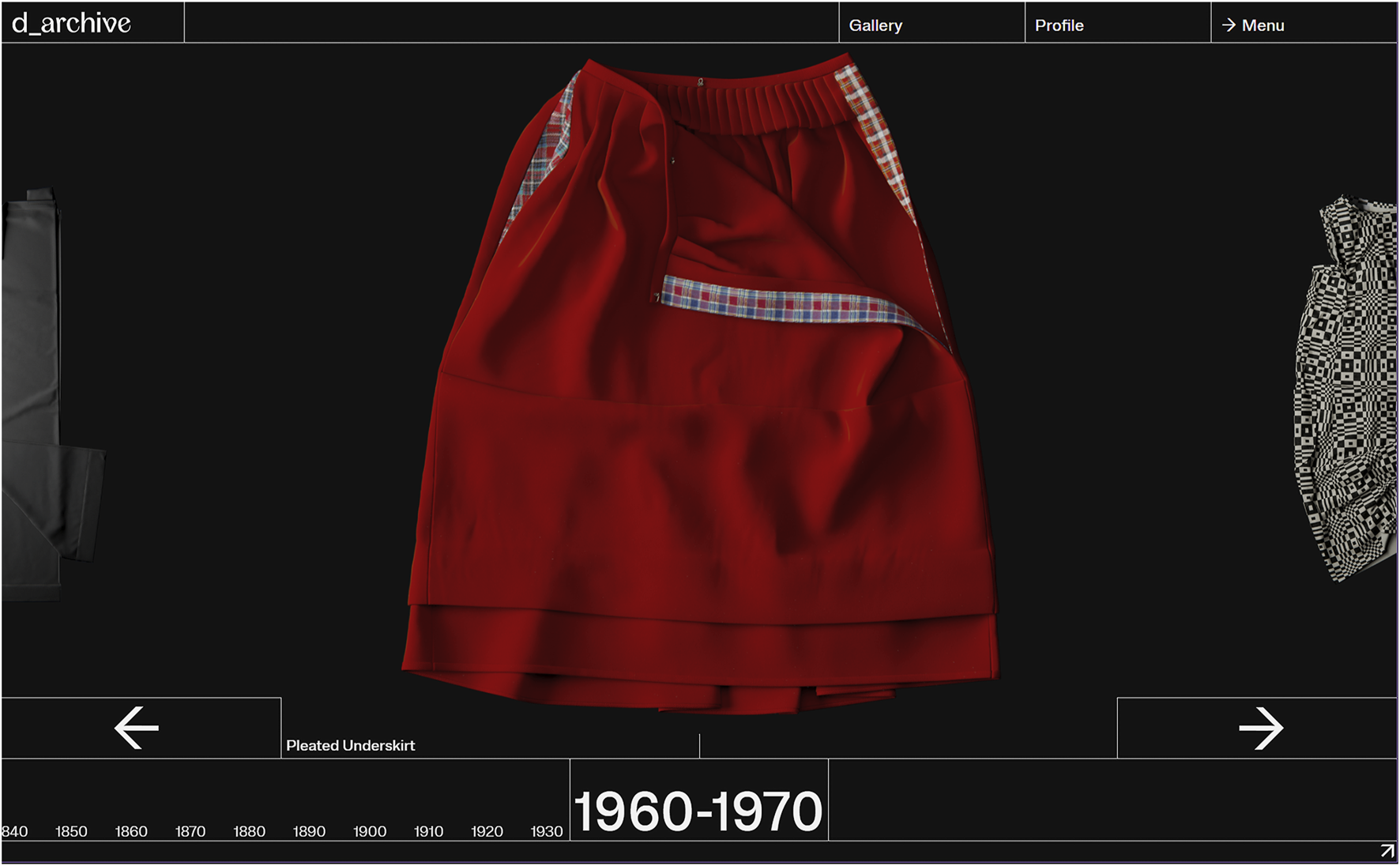
Screenshot from d_archive website gallery, showing the 3D replica of a wool pleated underskirt from MoMu’s Study Collection [item n. ST1515/2] (d_archive 2023).
FIGURE 3
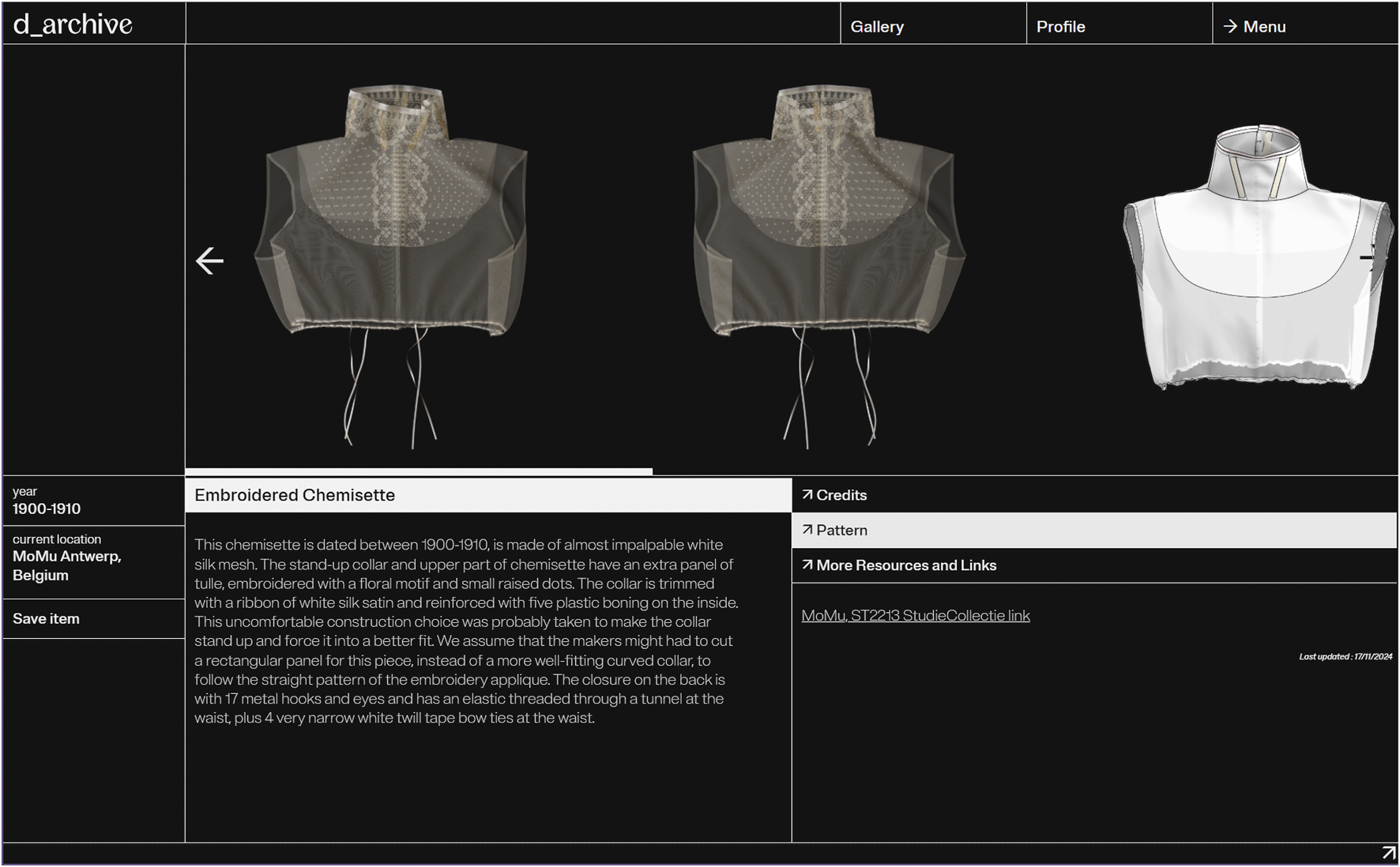
Screenshot from d_archive website gallery, showing the 3D replica of an embroidered chemisette from MoMu’s Study Collection [item n.ST2213] (d_archive 2023).
Theoretical framework
In fashion studies, dress history and fashion design research the artefacts (garments and accessories) play an important role functioning as documents that can be analysed as a primary source (Steele, 1998; Taylor, 2002; Mida and Kim, 2015), but also interpreted in light of a more subjective curatorial choice (De la Haye and Clark, 2008), as much as analysed by mixed methods (Jenss, 2016). Fashion artefacts are designed and produced, they are the outcome of a process that involves multiple steps and professional figures. Most important, fashion objects are situated, they are produced in a specific fashion system with defined characteristics. Acknowledging the coexistence of multiple fashion systems, not only the industrial one, (van der Voet, 2021: 18) it emerges that artefact-based research serves to contextualise fashion objects and describe them in light of the context where they were designed, produced, and assembled (See Buckley, 2021).
With the emergence of artefact-based approaches (Taylor, 2004) several historians and curators established various hands-on procedures for the study of clothes and fashion objects (Palmer, 2018). However, methods and methodological discourses for the study of fashion objects within museums and archives are still a fragmented field (Jenss, 2016: 11); the multifaceted characteristics of fashion research requires different approaches from multiple disciplines, not only from a theoretical perspective, but also considering practice-based, artistic research and design-based methods (See Teunissen, 2024). Considering the rise of digital tools in the field of fashion heritage and fashion exhibition (Colussi, 2024; Kang and Lin, 2024; Knoop and Ernst, 2024; Vandi, 2023; Vacca and Vandi, 2025), the research positions at the intersection between digitisation and fashion heritage. From the literature in the field, it emerges that digital technologies have been transforming the way fashion is studied, but also the way fashion heritage is preserved and accessed (Boughlala and Smelik, 2024; Bloemberg, 2024). The idea of accessibility is challenged by digital tools that often propose a kind of participation seemingly unlimited (Pecorari, 2019). Considering this perspective, the article explores the subject of material culture analysis for fashion research and digitisation focusing on three main topics: pattern making and fashion design; interoperability; workshop and study collection.
Pattern making and fashion design
Artefact-based approaches (Taylor 2004) are considered in the context of this paper as material methods (See Woodward, 2020) that involve a high amount of hands-on research, including photography, drawings, but also pattern making and sewing, showcasing that research methods for material culture analysis in fashion often overlaps with fashion design skills. For instance, pattern making and tailoring techniques have been in use for decades by fashion historians and archivists (Arnold, 1977; North and Tiramani, 2011). Moreover, the 1980s have seen a shift in Western museum’s interest towards a more comprehensive perspective in the study of fashion (Hammem, 2023). Museums started to showcase a particular interest in the making of fashion, as in the 1999 exhibition Geometrie (Verhelst, 1999) and in 2003 the exhibition Patronen Patterns (Debo, 2003) at the MoMu. The conservation of fashion sketches, for example, fostered a closer connection between the making of the garment and its design, including a new language: that of fashion drawing (Fava and Soldi, 2018). Following this perspective, the emergence of digital methods for the study of fashion heritage – such as digital craftsmanship and reverse engineering – promote a shift from a garment-centered approach to a more inclusive perspective (Vacca and Vandi, 2025 : 33) This shift places major importance on the ephemera and collateral materials (Pecorari, 2021), recognising fashion not only as a product – with garment as its final object – but as a process shaped by multiple voices, practices, and cultural narratives, wherein the designer is not the sole driving force behind the project (O’Neill, 2021). Skills and knowledge in fashion design - including pattern making and textile research – are important tools for the study of fashion heritage, capable of raising a different and more critical perspective on fashion objects and the context in which they were designed, produced and assembled (Buckley, 2021).
Interoperability of digital assets
In this context, an important added value lies in the potential for interoperability of the created digital assets. According to the Institute for Electrical and Electronics Engineering in the IEEE Standard Computer Dictionary, interoperability can be defined as “the ability of two or more systems or components to exchange information and to use the information that has been exchanged” (IEEE, 1991). Interoperability is considered one of the guiding principles for publishing information and data for scientific purposes–according to Wilkinson (et al.) scientific information and data should be published according to four foundational principles—Findability, Accessibility, Interoperability, and Reusability (Wilkinson, et al., 2016) – but, as this paper aims to demonstrate, also creative reuse can be greatly enhanced by interoperability. Digitising (e.g., scanning) a paper pattern transforms it into an image that can successively be vectorized to allow further digital editing; it can be imported in a software to be “stitched” together to create a 3D replica of a garment that can later be textured and animated. These cross-platform migrations can only happen when data formats, creative processes and information systems are interoperable. The outcome of these cross-platform migrations are new creations. In this sense, interoperability is not only to be understood as a requirement at an information-technical level, but also as a crucial component of the digital creative process.
Workshop and study collection
Sociologist Sophie Woodward, in her book Material Methods, outlines a series of approaches for studying objects by combining traditional methods—such as interviews and questionnaires—with design-led and art-based methods that leverage objects’ ability to elicit reactions from participants (Woodward, 2020). Workshops and participatory activities can influence the way objects are seen and enhanced, specifically within museum educational programs. In this perspective, in 2014 the project Re-visioni, curated by Gabriele Monti and held with the fashion design students of Iuav University of Venice, promoted the workshop approach applied to the idea of the study collection. The study collection is an essential tool for the studying and teaching of fashion design: a set of objects that, although chronologically distant, become suddenly highly accessible, as they can be closely examined and physically handled (Monti, 2014).
In MoMu’s collection book (Debo 2021), Birgit Ansoms and Dieter Suls describe the origins and role of the Study Collection, located in the MoMu Library & Dries Van Noten Study Center. Museum collections are treasure troves packed with information, but many are not accessible to visitors. The Study Collection consists of artefacts that are already well represented in the museum collection, that are fragmented or damaged, and that do not fit the narrowly defined museum collection profile. The departure point of the Study Collection dates back to 2011, with a donation of the handling collection of the Dutch collector Jacoba De Jonge to the museum’s library part of a much larger donation and acquisition of her collection to MoMu (Van Godtsenhoven et al., 2012). Together with a long-term loan from the University of Antwerp’s (UA) Faculty of Design Sciences, Department of Conservation Studies, this forms the basis of the Study Collection. Additionally, in collaboration with UA, a heritage project was set up to foster public engagement with the objects contained in the museum’s and university’s collections (Ortega Saez and Suls, 2016). Through various initiatives and projects, MoMu opens its Study Collection to a diverse audience across different age groups, promoting experimental approaches to the uses and study of fashion objects within museums. Currently, the collection holds over 2.000 pieces, made accessible in the reading room of the MoMu Library & Dries Van Noten Study Center.
Case studies
Digital archives: a playful exploration of fashion heritage
d_archive’s workshop Digital archives: a playful exploration of fashion heritage took place within the MoMu’s Library & Dries Van Noten Study Center. In recent years, MoMu had initiated the project Pattern-a-thon3 with the aim to translate physical garments into paper-patterns during a crowdsourced event. The results of these Pattern-a-thons are digitised and shared with an open license – e.g., CC.BY.SA4 – through a Wikimedia Commons page5. The workshop Digital archives: a playful exploration of fashion heritage took place on November 26th 2023. During the activity, ten participants were invited to work starting from the digital replicas created from the Pattern-a-thon project and from garments that were digitised on d_archive website. Participants were invited to re-invent the garments, to design a new object in the digital dimension (Figure 4). The workshop showcases the potential of applying a fashion design approach to archived materials, considering the potential of play and playfulness in re-working existing and historical sources that are dematerialised in a digital sphere. From the workshop it emerged: (i) drafting a pattern from an existing garment allows to access to another layer of the object: the paper/digital pattern; (ii) this paper/digital pattern is useful for fashion designers, but also amateurs and curious visitors to engage with the object from a more in-depth perspective, it functions as a language that participants can use to study the object; (iii) participatory and workshop activity foster engagement, playfulness and experimentation with the study collection, considering the potential of garments as sources that can be activated and re-activated in a fashion design process of post-production (Monti, 2010).
FIGURE 4
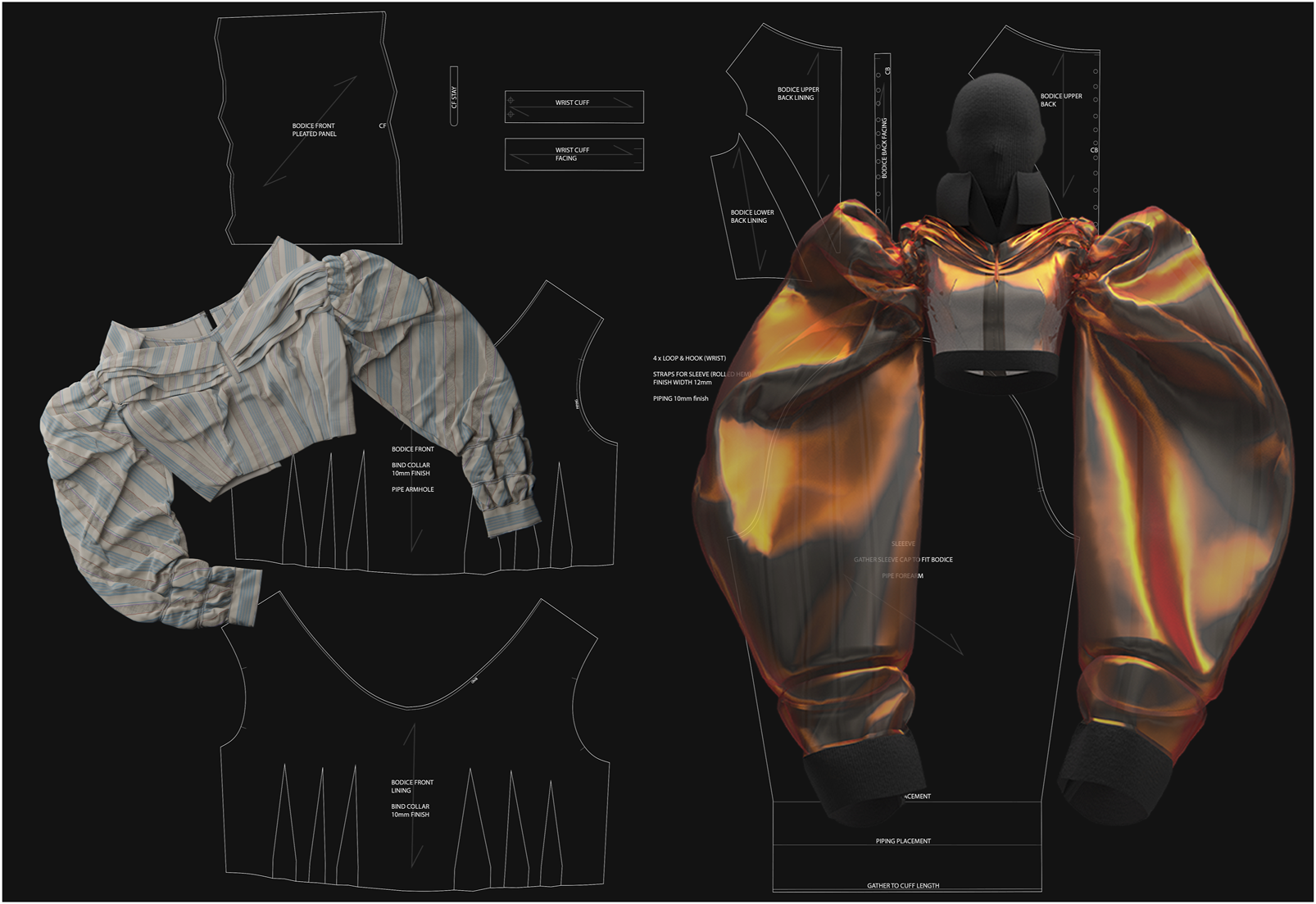
Render of the 3D replica of a striped bodice from MoMu’s Study Collection [item n.ST2177] next to Suza Vos’ 3D reinterpretation of it, outcome of the workshop “Digital Archives: a playful exploration of fashion heritage” (Suza Vos and d_archive 2023).
MoMu’s “Amazone ensemble” and d_archive at future front row
The holographic fashion show Future Front Row6 was presented in Antwerp during the Flanders Technology and Innovation Festival7 on the 23rd and 24th of March 2024. d_archive was invited by Masjien8, a Belgian agency for fashion, sustainability and technology, to work together with MoMu on the digitisation of a 115 year-old ensemble from the museum’s collection and set it in motion digitally for the show. The ensemble, made by german tailor Hermann Hoffmann consisted of 5 pieces: the Amazone Jacket9, the Amazone Jodhpurs10, the Amazone Skirt11 and 2 Amazone Gaiters12 (MoMu inventory numbers T12/1139ABCDE/B57).
This time the process initiated in the Museum’s Storage – the place where collections are stored in order to be preserved and are accessible only to the museum staff and to researchers upon specific requests. The project applied the reverse engineering method (Vacca and Vandi, 2023) consisting of several phases: artefact-based research and historical contextualisation; slow observation of the garment, sketches and photographs; pattern making and creation of the replica. The process involved an acknowledged pattern maker – Samira Lafkioui – drafting the patterns on paper, making calicos and tryouts of the garment, in order to get the most precise replica (Figure 5). During the close analysis of the garment, it emerged that a few buttons of the skirt were missing. While making the replica, d_archive attached the buttons in 3D to simulate its possible original appearance. This process can be defined as ‘digital restoration’ (Ding and Liang, 2024): while the button is still missing on the physical item, digital craftsmanship allows the creation of a restored version of the item in the digital sphere. Once the object was created, the motion capture of actors’ and dancers’ movements enabled the digital animation of an ensemble originally designed for sports activities but left untouched in an archive box for several decades. From the project it emerged: (i) the method of reverse engineering involves both pattern drafting skills and 3D drafting knowledge, it is a skillful and slow process that, for this reason, has been defined by d_archive as “digital craftsmanship;” (ii) the potential of the digital to restore the garment to its original shape; (iii) the potential of the digital to re-create movement and to set fragile objects in motion on a digital body. Similarly, in the exhibition Sleeping Beauty Reawakening Fashion (Bolton, 2022) a Charles Fredrick Worth gown was virtually restored and activated, in collaboration with Nick Knight, creating a virtually-moving figure using a reverse-engineer approach similar to that of d_archive13.
FIGURE 5

Four different angles and visualisation styles of the 3D replica of the Amazone ensemble from the MoMu collection [MoMu inventory numbers T12/1139ABCDE/B57] (d_archive 2024).
Fashion and interiors. A gendered affair - Maria Sèthe’s tea gown
As part of the exhibition Fashion & Interiors. A gendered affair at the MoMu (Cockx, 2025), d_archive was able to reconstruct, together with MoMu’s conservator Kim Verkens and pattern maker Stijn Van den Bulck, a speculative version of a tea gown made by Henry Van de Velde for and together with his wife, Maria Sèthe, (Figure 6) using the surviving embroidered panels and photographs of Maria Sèthe wearing the artefact together with a replica of the gown in Kunstmuseen Krefeld (Collection Textilmuseum Krefeld, inv. nr. 16483). The fragments of embroidered panels – the unique pieces of the garment that were preserved — were loaned to MoMu for the ‘Fashion and interiors’ exhibition, by the Museum für Gestaltung Zürich, Decorative Arts Collection, ZHdK (Cockx, 2025: 223). As a result, a video projection of an animated figure resembling Maria appears to be “walking in the room” of the exhibition wearing the digital garment. From the project it emerges that: (i) digital craftsmanship not only serves to create high quality 3D replicas of existing garments, but can also become a tool for research in the field of fashion history, actively participating in the methodology for material – and immaterial – culture analysis for the study of fashion; (ii) the research involved multiple figures and different Museums, showcasing that fashion heritage, and fashion at large, is never a one-person practice, rather, it is a multidisciplinary field that requires different knowledges and professional figures; (iii) digital tools, when implemented with in-depth research, material culture, and photographic sources, can propose alternative ways to showcase garments within fashion exhibitions.
FIGURE 6
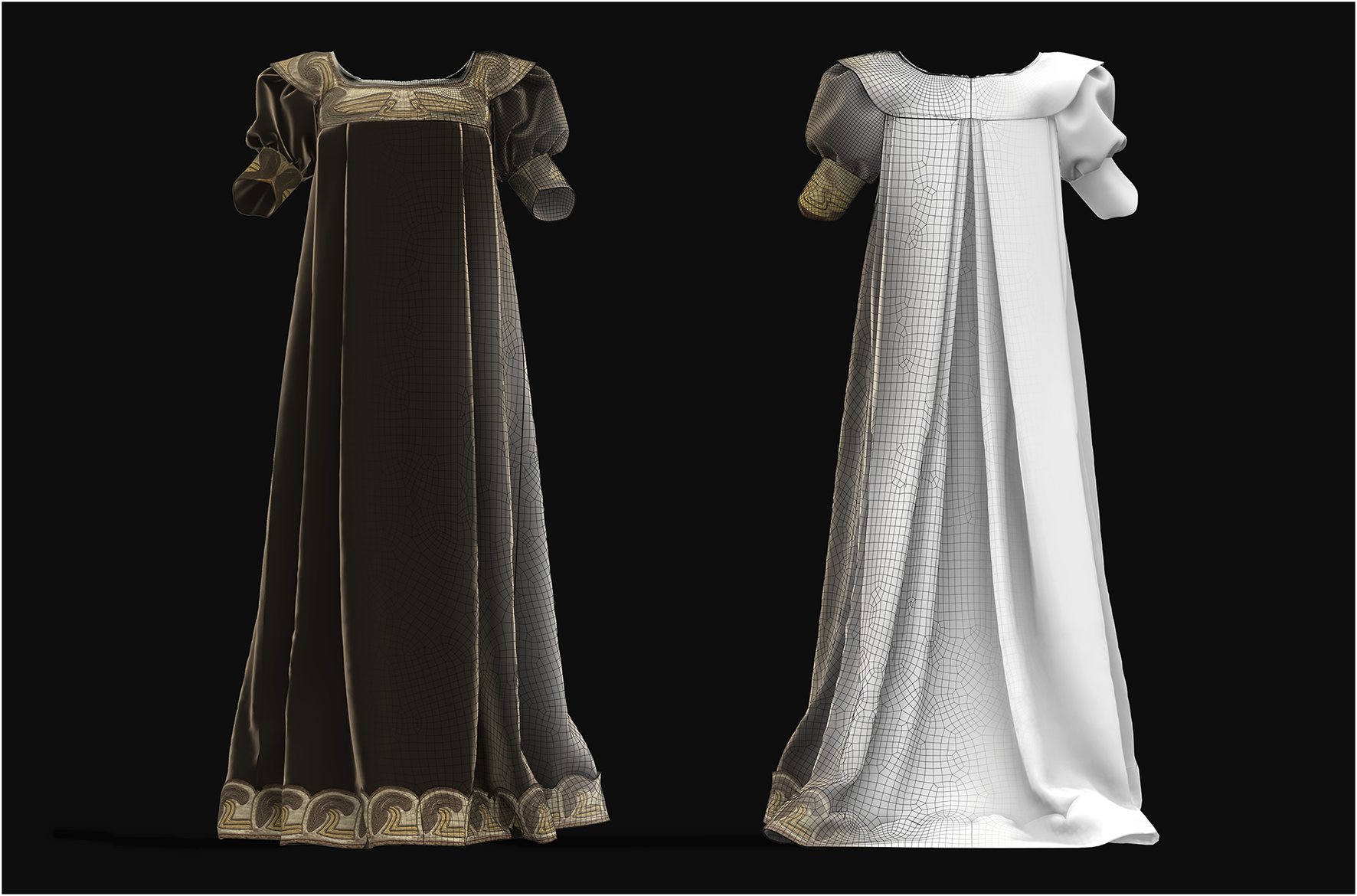
Front and back view, with a gradient of visualisation styles, of the Maria Sèthe tea gown [Collection Textilmuseum Krefeld, inv. nr. 16483] (d_archive 2025).
Conclusion
By observing the work of d_archive via several case studies within the context of the listed theoretical framework, a few conclusions could be highlighted (Figure 7).
FIGURE 7
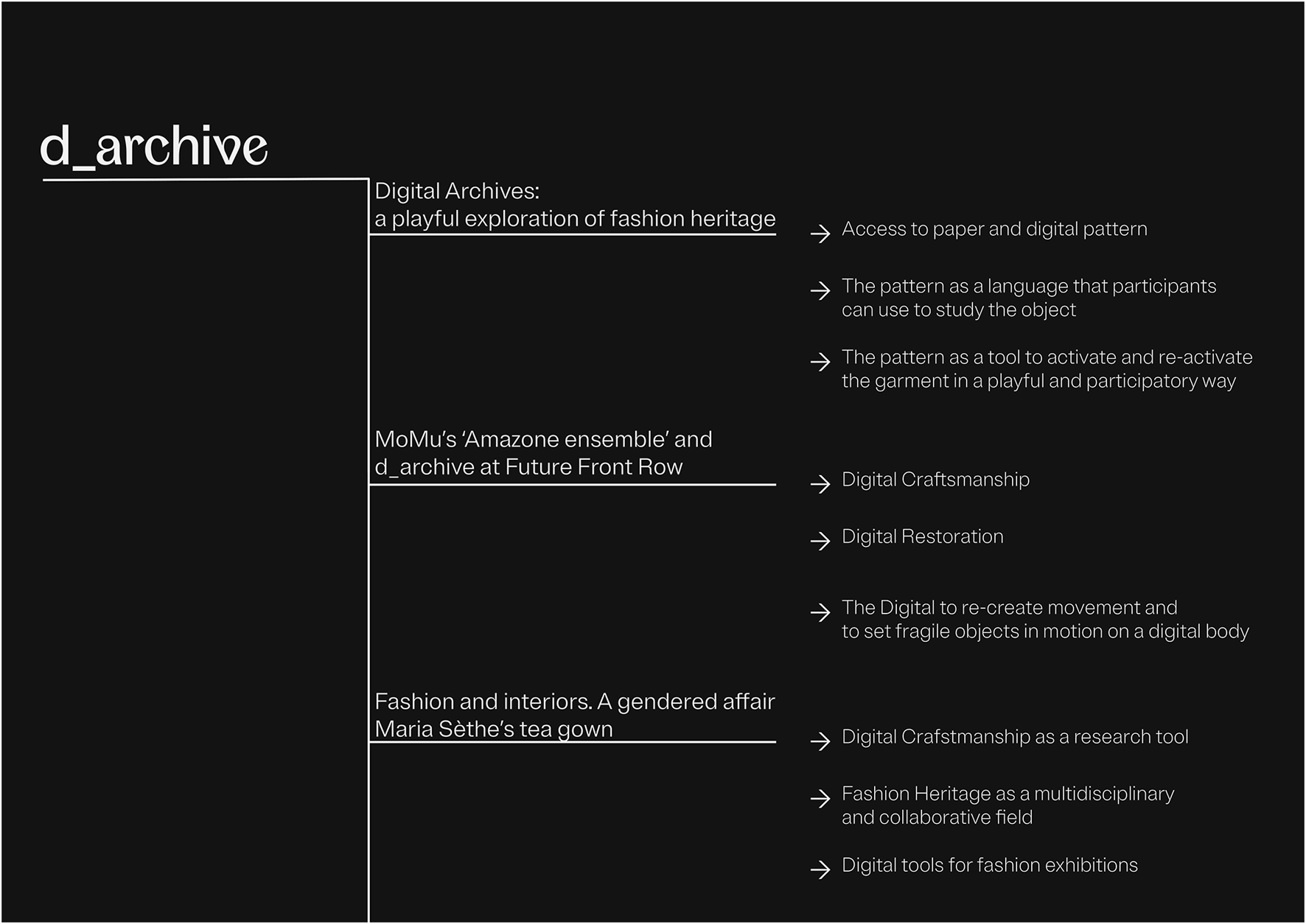
Schematic representation of this article’s conclusions.
Paper(digital)-pattern and participation
From the first case study (3.1), it emerges the relevance of pattern making as a language to study garments as sources for fashion research, but also as a tool to interact with the garment and interpret it from a technical and creative perspective, taking ownership of the design in a participatory way. d_archive’s projects allows one to go a layer deeper in the analysis of the garment, following a pre-established method already in use by fashion historians (Arnold, 1977; Kirke, 1998; North and Tiramani, 2011; Palmer, 2018). Moreover, making the garment’s pattern requests an in-depth analysis of the object, leading to a close examination and a slow approach to seeing (Mida and Kim, 2015). However, to the general public, patterns can be seen as a schematic object, understandable only to the insiders of the field (Lauwaert in Debo, 2003: 48), which might become exclusive and inaccessible. MoMu’s and d_archive’s approach to pattern making, through workshop and participatory activities, makes it accessible for visitors to get closer to the language and to learn basic aspects via a playful, hands-on activity. Digital downloadable patterns became available and accessible to a wider audience in an open-source perspective for further interpretation. This creates long term accessibility to the public of more fragile objects that are often unavailable and hidden in Museum’s storages.
Defining a method: “digital craftsmanship”
The second case study (3.2) guides in the definition of ‘digital craftsmanship’: d_archive’s method that involves the time-consuming activity of reverse engineering (Vacca and Vandi, 2023). The method of digital craftsmanship involves multiple skills and knowledge concerning the translation from the physical to the digital (Knoop and Ernst, 2024), that implies material sensibilities related to physical and digital textile, bodies and proportions. In this context, interoperability plays a key role, facilitating transformation and repurpose of the data pipeline; it is a crucial precondition of the entire workflow. In fact, the wide amount of physical and digital work served to develop and craft the Amazone Ensemble aims to show that craftsmanship exists also in the 3D translation and it happens through interoperability of the digitalised data, challenging the idea that digital processes must be purely automated and efficient. Achieving accurate shapes, volumes, and draping in 3D relies on real-world material knowledge, creating a continuous exchange between physical and digital expertise.
Positioning the method within fashion research
As already underlined in 2019 by Pecorari “The digital realm has indeed challenged the most central duty of the museum: its responsibility towards education and material knowledge.” (2019 : 12). Through the reconfiguration of Maria Sèthe’s tea gown – the third case study (3.3) - it is noticeable how digital tools can support and integrate fashion research in terms of accessibility and knowledge creation – specifically in regards to d_archive works, as an independent collective of creatives and practitioners that does not aim to overcome material practices, but rather to integrate and evolve them. Still, a critical perspective arises in relation to the physical object which, indeed, deserves material consideration and physical engagement (Kang and Lin, 2024). Moreover, as mentioned by Cristina Baldacci in her book Archivi Impossibili, in times of knowledge crises, we must acknowledge that any attempt to categorize reality remains arbitrary and imperfect, shaped by the biases and conceptual frameworks of its creators (Baldacci, 2017). Considering the potential of digital tools in making and re-making (O’Neill, 2021) physical objects, digital tools for fashion research might facilitate a critical analysis of fashion sources from more artistic and design based perspectives.
Statements
Data availability statement
The original contributions presented in the study are included in the article/supplementary material, further inquiries can be directed to the corresponding authors.
Author contributions
AV wrote the introduction, methodology, 3 and 3.1 of the theoretical framework and contributed to part 3.3; case study and conclusion are written by AV with contribution by MP and DS. MP wrote 1.2 An introduction to d_archive and has contributed to the case study and conclusion. DS wrote 3.2 and 3.3 of the theoretical framework with contribution by AV, and contributed to the case study and conclusion. Field research has been conducted by d_archive (MP) in collaboration with MoMu (DS). All authors contributed to the article and approved the submitted version.
Funding
The author(s) declare that no financial support was received for the research and/or publication of this article.
Acknowledgments
Practice and field research has been carried out by d_archive members Virgile Biosa, Erisa Ibrahimi, Martina Ponzoni and Daniele Scarante, in collaboration with MoMu, among which, Dieter Suls, Kim Verkens, Stijn Van den Bulck, Samira Lafkioui.
Conflict of interest
Author MP was employed by the company d_archive B.V. Author DS was employed by the organisation ModeMuseum Antwerpen.
The remaining author declares that the research was conducted in the absence of any commercial or financial relationships that could be construed as a potential conflict of interest.
Generative AI statement
The author(s) declare that no Generative AI was used in the creation of this manuscript.
Footnotes
1.^Online: https://darchive.io/about/ [accessed on 17th March 2025].
3.^Online: https://www.momu.be/en/magazine/pattern-a-thon [Accessed 27th March 2025].
4.^Online: https://creativecommons.org/licenses/by-sa/4.0/ [Accessed 27th March 2025].
5.^Online: https://commons.wikimedia.org/wiki/Category:MoMu_Pattern-a-thon [Accessed 27th March 2025].
6.^Online: https://www.isabelleudo.com/pillars/futurefrontrow [Accessed 29th March 2025].
7.^Online: https://fti.vlaanderen/ [Accessed 29th March 2025].
8.^Online: https://masjien.be/ [Accessed 29th March 2025].
9.^Online: https://darchive.io/jacket/ [Accessed 29th March 2025].
10.^Online: https://darchive.io/jodhpurs/ [Accessed 29th March 2025].
11.^Online: https://darchive.io/skirt/ [Accessed 29th March 2025].
12.^Online: https://darchive.io/gaiters/ [Accessed 29th March 2025].
13.^Online: https://www.youtube.com/watch?v=g4s-UJrLZAY [Accessed 29th March 2025].
References
1
Arnold J. (1977). Patterns of fashion 2: English women’s dresses and their construction c1860–1940. London: Macmillan.
2
Baldacci C. (2017). Archivi impossibili: un'ossessione dell'arte contemporanea. Milan: Johan and Levi.
3
Bloemberg N. (2024). The future of fashion heritage is digital. Situ52. 10.4000/insitu.40454
4
Bolton A. (2022). Sleeping beauties: reawakening fashion (New York: Metropolitan Museum of Art). [Exhibition catalogue, The Met, New York.
5
Boughlala A. Smelik A. (2024). Tracing the history of digital fashion history and culture. Cloth. Text. Res. J., 1–16. 10.1177/0887302X241283504
6
Buckley C. (2021). “Made in patriarchy II: researching (or re-searching) women and design,” in Design struggles: intersecting histories, pedagogies, and perspectives. Editors MareisC.PaimN. (Amsterdam: Valiz), 43–57.
7
Cardano M. Gariglio L. (2023). Metodi qualitativi: pratiche di ricerca in presenza e a distanza. Rome: Carocci Editore.
8
Cockx R. (2025). Fashion and interiors: a gendered affair. Antwerp: hannibal books and MoMu - fashion museum Antwerp. [Exhibition catalogue, MoMu - Fashion Museum Antwerp, March – August 2025].
9
Colussi D. (2024). “Virtual bodies, digital clothes, synthetic worlds,” in Memorabile. Ipermoda. Venice: marsilio. Editor FrisaM. L.[Exhibition catalogue, Museo MAXXI, Rome, November 2024 – April 2025].
10
Debo K. (2003). Patronen patterns. Exhibition catalogue. Antwerp: ModeMuseum. Ghent: Ludion. [Exhibition catalogue, MoMu - Fashion Museum Antwerp, April – August 2003].
11
Debo K. (2021). Fashion: the MoMu collection Antwerp. Tielt Lannoo.
12
de la Haye A. Clark J. (2008). One object: multiple interpretations. Fash. Theory.12 (2), 137–169. 10.2752/175174108x298962
13
Ding Q.-K. Liang H.-E. (2024). Digital restoration and reconstruction of heritage clothing: a review. Herit. Sci.12 (1), 225. 10.1186/s40494-024-01349-4
14
Fava E. Soldi M. (2018). “Moda media storia: La ricerca di moda allo CSAC,” in Laboratorio Italia: canoni e contraddizioni del Made in Italy. Milan: Mimesis. Editors BorgheriniM.MariniS.MengoniA.SacchiA.VaccariA., 174–189.
15
Hammem E. (2023). The crafts of fashion. Paris: Editions B42, 1.
16
IEEE (1991). IEEE standard computer dictionary: a compilation of IEEE standard computer glossaries, 610. IEEE Std, 1–217. 10.1109/IEEESTD.1991.106963
17
Jenss H. (2016). Fashion studies: research methods, sites and practices. London: Bloomsbury Publishing.
18
Kang J.-Y. M. Lin S.-H. (2024). Building three-dimensional virtual historic fashion museum exhibitions: from the perspective of technology affordances. Cloth. Text. Res. J.43, 137–153. [Epub ahead of print]. 10.1177/0887302X241257714
19
Kirke B. (1998). Madeleine vionnet. San Francisco: Chronicle Books.
20
Knoop D. Ernst M. (2024). Unlocking fashion heritage: a manual for digitising collections. Modemuze, digital publication. Available online at: https://modemuze.nl/sites/default/files/2024-12/MM%20Flowchart%20Digitalisering%20v06.pdf (Accessed June 11, 2025).
21
Mida I. Kim A. (2015). The dress detective: a practical guide to object-based research in fashion. London: Bloomsbury Visual Arts.
22
Monti G. (2010). “Immagini dall’archivio,” in Elda Cecchele in forma di tessuto. Venice: Marsilio. Editors FrisaM. L.MontiG., 44–39. [Exhibition catalogue, Spazio Espositivo Lanificio Conte Largo Fusinelle Schio, December 2010 - February 2011].
23
Monti G. (2014). “Re-visioni: esercizi a partire da una study collection,” in Venice: Università Iuav di Venezia.
24
North S. Tiramani J. (2011). Seventeenth-century women’s dress patterns (London: V&A Publishing).
25
O’Neill A. (2021). Exploding fashion: making, unmaking, and remaking twentieth-century fashion. London: Lannoo Publishers.
26
Ortega Saez N. Ortega Saez D. (2016). “The RE-usable Fashion Museum: crowdfunding a study collection at MoMu (Antwerp) / object-based pedagogy and engaged practice using a study collection at the Antwerp University,” in Museums and Cultural Landscapes: Proceedings of the ICOM Costume Committee Annual Meeting, Milan, Editor J. Pietsch. (ICOM Costume Committee).
27
Palmer A. (2018). Christian Dior: history and modernity, 1947–1957. Munich: Hirmer Verlag.
28
Pecorari M. (2019). Fashion archives, museums and collections in the age of the digital. Crit. Stud. Fash. and Beauty10 (1), 3–29. 10.1386/csfb.10.1.3_7
29
Pecorari M. (2021). Fashion remains: rethinking the ephemera in the archive. London: Bloomsbury Publishing.
30
Steele V. (1998). A museum of fashion is more than a clothes-bag. Fash. Theory2 (4), 327–335. 10.2752/136270498779476109
31
Taylor L. (2002). Establishing Dress History. Manchester: Manchester University Press.
32
Taylor L. (2004). The Study of Dress History. Manchester: Manchester University Press.
33
Teunissen J. (2024). “The transformative power of practice-based fashion research,” in Fashion knowledge: theories, methods, practices and politics. Editors GaugeleE.TittonM. (Bristol: Intellect Ltd), 15–26.
34
Vacca F. Vandi A. (2023). “Fashion archives as metamedium: unfolding design knowledge through digital techniques,” in Connectivity and creativity in times of conflict (Cumulus Antwerp), 378–383.
35
Vacca F. Vandi A. (2025). Fashioning cultural entrepreneurship: the role of heritage in dissemination, didactic and research activities among stakeholders. Eur. J. Cult. Manag. Policy14. 10.3389/ejcmp.2024.13577
36
Van Godtsenhoven K. de Jonge J. Mertens W. Sorber F. Hohé M. Sloof R. (2012). Een leven in mode: Vrouwenkleding 1750–1950 uit de collectie Jacoba de Jonge = Living Fashion: Women’s Daily Wear from 1750–1950 from the Jacoba de Jonge Collection. Introduction by K. Debo. Tielt: Lannoo
37
van der Voet H. Reponen J. (2021). Warehouse Review 002: A Review of Reviews. Amsterdam: Warehouse.
38
Vandi A. (2023). Dealing with objects, dealing with data. ZoneModa J.13 (1S), 155–168. 10.6092/issn.2611-0563/17935
39
Vaughan L. (2017). Practice-Based Design Research. New York: Bloomsbury Academic.
40
Verhelst B. (1999). Geometrie / Geometry. Antwerp: MoMu ‐ ModeMuseum.
41
Wilkinson M. D. Dumontier M. Aalbersberg I. J. Appleton G. Axton M. Baak A. et al (2016). The FAIR Guiding Principles for scientific data management and stewardship. Sci. Data3, 160018. 10.1038/sdata.2016.18
42
Woodward S. (2020). Material Methods: Researching and Thinking with Things. London: SAGE Publications Ltd.
Summary
Keywords
fashion archive, study collection, digital craftsmanship, 3D replica, digital pattern making
Citation
Varisco A, Ponzoni M and Suls D (2025) “Digital craftsmanship” as a methodology for fashion research. Eur. J. Cult. Manag. Policy 15:14770. doi: 10.3389/ejcmp.2025.14770
Received
16 April 2025
Accepted
22 July 2025
Published
12 August 2025
Volume
15 - 2025
Updates
Copyright
© 2025 Varisco, Ponzoni and Suls.
This is an open-access article distributed under the terms of the Creative Commons Attribution License (CC BY). The use, distribution or reproduction in other forums is permitted, provided the original author(s) and the copyright owner(s) are credited and that the original publication in this journal is cited, in accordance with accepted academic practice. No use, distribution or reproduction is permitted which does not comply with these terms.
*Correspondence: Alessandra Varisco, avarisco@iuav.it; Martina Ponzoni, ponz@darchive.io; Dieter Suls, dieter.suls@momu.be
Disclaimer
All claims expressed in this article are solely those of the authors and do not necessarily represent those of their affiliated organizations, or those of the publisher, the editors and the reviewers. Any product that may be evaluated in this article or claim that may be made by its manufacturer is not guaranteed or endorsed by the publisher.